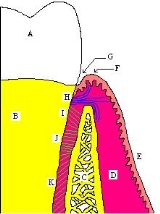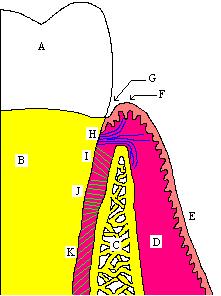
Gingival fibers
Encyclopedia
The gingival fibers are the connective tissue
fibers that inhabit the gingival tissue
adjacent to teeth and help hold the tissue firmly against the teeth. They are primarily composed to type I collagen
, although type III fibers are also involved.
These fibers, unlike the fibers of the periodontal ligament
, in general, attach the tooth to the gingival tissue, rather than the tooth to the alveolar bone.
(labelled G in the diagram) increases in depth apically, allowing more debris and bacteria
to remain in intimate contact with the delicate sulcular
and junctional epithelia
for longer times.
 There are three groups within which gingival fibers are arranged:
There are three groups within which gingival fibers are arranged:
Connective tissue
"Connective tissue" is a fibrous tissue. It is one of the four traditional classes of tissues . Connective Tissue is found throughout the body.In fact the whole framework of the skeleton and the different specialized connective tissues from the crown of the head to the toes determine the form of...
fibers that inhabit the gingival tissue
Gingiva
The gingiva , or gums, consists of the mucosal tissue that lies over the mandible and maxilla inside the mouth.-General description:...
adjacent to teeth and help hold the tissue firmly against the teeth. They are primarily composed to type I collagen
Collagen
Collagen is a group of naturally occurring proteins found in animals, especially in the flesh and connective tissues of mammals. It is the main component of connective tissue, and is the most abundant protein in mammals, making up about 25% to 35% of the whole-body protein content...
, although type III fibers are also involved.
These fibers, unlike the fibers of the periodontal ligament
Periodontal ligament
The periodontal fiber or periodontal ligament, commonly abbreviated as the PDL, is a group of specialized connective tissue fibers that essentially attach a tooth to the alveolar bone within which it sits...
, in general, attach the tooth to the gingival tissue, rather than the tooth to the alveolar bone.
Functions of the gingival fibers
The gingival fibers accomplish the following tasks:- They hold the marginal gingivaFree gingival marginThe free gingival margin is the interface between the sulcular epithelium and the epithelium of the oral cavity. This interface exists at the most coronal point of the gingiva, otherwise known as the crest of the marginal gingiva....
against the tooth - They provide the marginal gingiva with enough rigidity to withstand the forces of masticationMasticationMastication or chewing is the process by which food is crushed and ground by teeth. It is the first step of digestion and it increases the surface area of foods to allow more efficient break down by enzymes. During the mastication process, the food is positioned between the teeth for grinding by...
without distorting - They serve to stabilize the marginal gingiva by uniting it with both the tissue of the more rigid attached gingiva as well as the cementumCementumCementum is a specialized calcified substance covering the root of a tooth. Cementum is excreted by cells called cementoblasts within the root of the tooth and is thickest at the root apex. These cementoblasts develop from undifferentiated mesenchymal cells in the connective tissue of the dental...
layer of the tooth.
Gingival fibers and periodontitis
In theory, gingival fibers are the protectors against periodontitis, as once they are breached, they cannot be regenerated. When destroyed, the gingival sulcusGingival sulcus
The gingival sulcus is an area of potential space between a tooth and the surrounding gingival tissue and is lined by sulcular epithelium. The depth of the sulcus is bounded by two entities: apically by the gingival fibers of the connective tissue attachment and coronally by the free gingival...
(labelled G in the diagram) increases in depth apically, allowing more debris and bacteria
Bacteria
Bacteria are a large domain of prokaryotic microorganisms. Typically a few micrometres in length, bacteria have a wide range of shapes, ranging from spheres to rods and spirals...
to remain in intimate contact with the delicate sulcular
Sulcular epithelium
The sulcular epithelium is that epithelium which lines the gingival sulcus. It is apically bounded by the junctional epithelium and meets the epithelium of the oral cavity at the height of the free gingival margin. The sulcular epithelium is nonkeratinized....
and junctional epithelia
Junctional epithelium
The junctional epithelium is that epithelium which lies at, and in health also defines, the base of the gingival sulcus. It attaches to the surface of the tooth with hemidesmosomes and is, on average, roughly 1 mm in width, constituting about one half of the biologic width.The junctional...
for longer times.
Types of gingival fibers

- dentogingival group - there are three types of fibers within this group:
- fibers that extend towards the crest of the gingiva
- fibers that extend laterally to the outer surface of the gingiva and
- fibers that extend outward, past the height of the alveolar crest, and then downward along the cortex of the alveolar bone.
- circular group - these fibers are unique in that they exist entirely within the gingiva and do not contact the tooth
- transseptal group - these fibers have traditionally been described as spanning the interproximal tissue between adjacent teeth, into which they are embedded. However, two other types of fibers have been described in this group:
- semicircular fibers - fibers that run through the facial and lingualCommonly used terms of relationship and comparison in dentistryThere are numerous commonly used terms of relationship and comparison that refer to different aspects of teeth and are frequently utilized in articles about dentistry...
gingiva around each tooth, attaching to the interproximalCommonly used terms of relationship and comparison in dentistryThere are numerous commonly used terms of relationship and comparison that refer to different aspects of teeth and are frequently utilized in articles about dentistry...
surfaces of the same tooth. - transgingival fibers - fibers that run between two non-adjacent teeth and are embedded in the cementumCementumCementum is a specialized calcified substance covering the root of a tooth. Cementum is excreted by cells called cementoblasts within the root of the tooth and is thickest at the root apex. These cementoblasts develop from undifferentiated mesenchymal cells in the connective tissue of the dental...
of their proximal surfaces, passing around the tooth in the middle of the two teeth attached with these fibers.
- semicircular fibers - fibers that run through the facial and lingual

